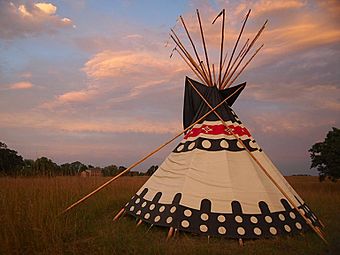Upper Sioux Agency State Park facts for kids
Quick facts for kids |
|
|
Upper Sioux Agency
|
|
 |
|
| Location | 5908 Highway 67, Sioux Agency Township, Minnesota |
|---|---|
| Nearest city | Granite Falls, Minnesota |
| Built | 1854 |
| NRHP reference No. | 70000315 |
| Added to NRHP | October 15, 1970 |
Upper Sioux Agency State Park is a special place in Minnesota. It's a state park located along the Minnesota River, just south of Granite Falls. This park helps protect the historic site of the Upper Sioux Agency, also known as the Yellow Medicine Agency.
This important site was destroyed during the Dakota War of 1862. Today, it's recognized as a significant historical place. It was added to the National Register of Historic Places in 1970 because of its importance in history, architecture, education, and archaeology. A respected leader named Chief Walking Iron Mazomani, from the Wahpetonwan Dakota people, is buried here. He died during the 1862 Dakota War.
Contents
What Was the Upper Sioux Agency?
The Upper Sioux Agency was like a government office built in 1854. It was set up by the United States government. Its main purpose was to manage agreements and provide supplies to the Dakota people.
This agency was meant to help the Dakota tribes. It was supposed to give them food, tools, and other goods. These items were promised in treaties, which are formal agreements.
Life at the Agency
The agency had several buildings. There were homes for the agents and their staff. It also had storage buildings for supplies. A school was even built there for Dakota children.
The agency was a place where different cultures met. It was a center for trade and communication. People came to get their supplies and discuss important matters.
Why Was It Important?
The Upper Sioux Agency was very important to the Dakota people. It was a key part of their relationship with the U.S. government. Many decisions that affected their lives were made there.
It was also a place where the Dakota people tried to adapt to new ways. They learned about farming and other skills. This was part of the government's plan to change their traditional lifestyle.
The Dakota War of 1862
The Upper Sioux Agency played a sad role in the Dakota War of 1862. This war was a conflict between the Dakota people and the United States. It happened because of many broken promises and difficult living conditions.
The Dakota people were facing starvation. The supplies they were promised often did not arrive. They were also losing their land. These problems led to great anger and frustration.
The Agency's Destruction
In August 1862, the war began. The Upper Sioux Agency was one of the first places attacked. It was destroyed by Dakota warriors.
The destruction of the agency marked the start of a difficult period. It showed the deep conflict and hardship of the time. Many lives were lost during this war.
Chief Walking Iron Mazomani
Chief Walking Iron Mazomani was a brave leader of the Wahpetonwan Dakota. He was known for his wisdom and strength. He played a role in the events of the 1862 war.
He died during the Battle of Wood Lake. This battle was a major fight during the war. His burial place at the park reminds us of the people who lived and died there.
Upper Sioux Agency State Park Today
Today, the site is a peaceful state park. It helps us remember the history of the area. The park protects the land where these important events happened.
Visitors can learn about the Dakota people. They can also learn about the history of the agency. It's a place for reflection and understanding.
What Can You Do at the Park?
Upper Sioux Agency State Park offers many activities. You can go hiking on the trails. These trails wind through beautiful natural areas.
The park is also a great place for camping. You can spend a night under the stars. It's a perfect spot to enjoy nature and learn about the past.
Protecting History
The park helps protect the remains of the old agency. Archaeologists study the site to learn more about its past. They uncover clues about how people lived there.
By visiting the park, you help keep this history alive. It's important to remember the stories of the past. This helps us understand our world today.



